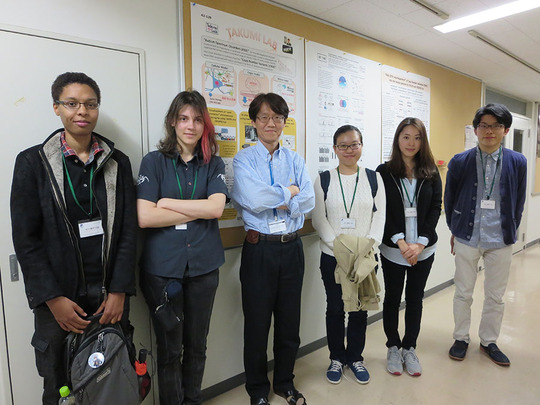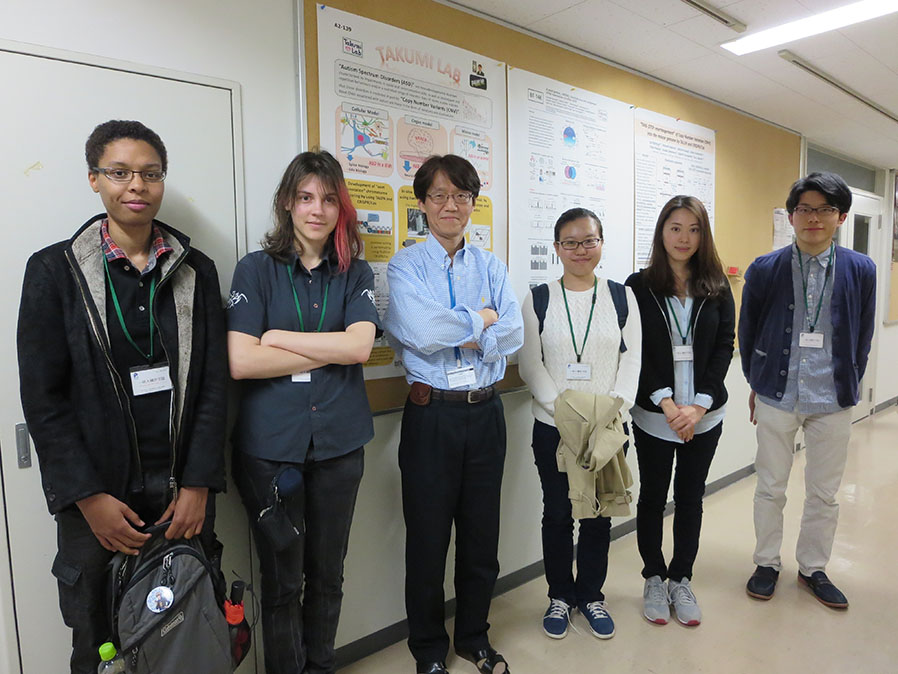
“Course VI 〜 Visit to the RIKEN Brain Science Institute (Wako-shi)” Report Lana SINAPAYEN
- Date:
- 17:00-19:00, Tuseday, April 28, 2015
- Location:
- RIKEN Brain Science Institute (Wako-shi)
- Speaker:
- Toru Takumi, M.D., Ph.D. (RIKEN Brain Science Institute / Mental Biology Senior Team Leader)
- Organized by:
- the Educational Project 3 "Science, Technology, and Inclusive Society", Integrated Human Sciences Program for Cultural Diversity, The University of Tokyo
- Collaboration:
- RIKEN Brain Science Institute (Wako-shi), Mental Biology research team
Summary
This class was given by Pr. Takumi from the RIKEN Brain Science Institute. In addition to the IHS staff, the participants were mainly students from the IHS program (1st and 2nd year) and students from the Ishiura Laboratory.
Pr. Takumi is the senior team leader of the Mental Biology research team in the Brain Sicence Institute. Originally from the Kansai region, he recently moved to Tokyo to join the Wako branch of Riken. His team studies mental illnesses using animal models such as mice.
Since IHS students have very different backgrounds, not always related to biology, Pr. Takumi's talk started with very basic definitions. The function of RNA, the influence of environment on gene expression (epigenetics), stem cells, the role of twin studies were some of the subjects evoked.
The main topic of the talk was autism, or rather, the autism spectrum. Recently, the consensus on mental illnesses shifted from a many-to-one mapping of «well-defined symptoms corresponding to one distinct illness» to a spectrum of symptoms that may correspond to a spectrum of illnesses. In the case of autism, the symptoms may include low sociability, gaze avoidance, obsessive hobbies, and difficulties to communicate. The severity and consequences of the symptoms are very variable.
After a non-scientific era of blaming mothers for their kids' autism, a number of studies focused on finding genes that might be implicated in inducing symptoms corresponding to the autistic spectrum. The results showed that a great number of genes, situated on many different chromosomes, could be linked to autistic behavior. Unlike other conditions, one single gene or chromosome is not responsible for autism.
Nevertheless, Pr. Takumi's team decided to use a genetically modified "mouse model" to study autism. Mice have been used as models for human illnesses for a long time, because their genome is well known and it is possible to find equivalences between their genes and human genes. Therefore it is possible to induce "human-like" conditions in mice by engineering their DNA.
Pr. Takumi's team used mice with one modified gene that is knows to be linked to autistic behavior in humans, and studied the mice's behavior. They found that these mice had reduced interest for social interactions, produced unusual sounds compared to non-modified mice, and had a hard time changing learned habits.
This behavior does sound like the mice are "autistic", but Pr. Takumi warned about jumping to conclusions: our natural interpretation is that the modified mice are autistic, but it is very difficult to prove that the mice's symptoms are really comparable to human symptoms (social interactions in mice are different from social interactions in humans), and to prove that comparable symptoms are due to comparable causes.
In consequence, a drug that would be successfully tested on "autistic mice" would not be guaranteed to have the same effect on people on the autism spectrum.
My point of view as an Artificial Intelligence (AI) researcher
I build and study artificial neural networks, with the goal of achieving intelligent behavior in robots. These studies require to think about what may be common to living beings that allow them to exhibit "intelligent behavior". There are almost as many definitions of intelligent behavior as there are scientists in the field, therefore theoretical discussions can get quite passionate...
The biggest realization for me during this course was the number of contradictions that we, not only as a group but even as individual scientists, must face when dealing with models of human behavior. In theory, we make a big deal of proving that humans are not animals just like other animals. The default stance is to consider that other animals are stupid until proven otherwise, even if it means changing the definition of "stupid"with each new discovery challenging our views on animal behavior. On the other hand, we use animal models to study issues related to "higher (sic) cognition" in humans: depression, schizophrenia, autism. Furthermore, part of the scientific community considers that the "mind" is separate from the body. For that part of the community, growing a brain in a dish, its in sillico equivalent of simulating disembodied brains inside computers, and generally considering the brain as an autonomous organ are ideas that make sense.
On the other hand, we do know that "mental" illnesses are environment-dependent; that we can induce them with changes in DNA; that brains do not develop correctly without the right embodiment; that "mental" illnesses affect the body's sensory input and motor output. As these contradictions make me uneasy, my personal opinion is a radical one. I do think that humans are perfectly average animals, which is why we manage to use other animal models as a surrogate to human models. I am also a proponent of "Radical Embodied Cognition" 1 : I think that brains do no exist in a vacuum and I do not believe that brains as a unit distinct from the rest of the body are the seat of intelligence. I do not believe in an ethereal "mind" floating somewhere in our brains. I do not think that we can grow functional brains in dishes (or isolated computers).
To me the most interesting part of the talk was the presentation of Pr. Takumi's team results. But it also made me think more broadly about how personal beliefs shape scientific research. My research as a Master student focused on designing and implementing mathematical models for teams of flying robots. The tasks of the robots were relatively complex: explore a room, analyze sounds, collaborate to find targets. Yet in the middle of my work, when I looked at my robots and wondered, "do I think of these robots as intelligent?", the answer was clearly "no". The robots do what I tell them to, but they have no idea what they are doing or why they do it. Their task only have a meaning for us, humans, who designed the robots and the algorithms they use.
After this realization, I took the complete opposite path for my PhD research. Now, I simulate "robot's brains" that learn extremely simple tasks. I do not implant mathematical models representing the world inside the robot's brain; what really emerges in its brain is completely dependent on the interactions between the robot's body and its environment. Paradoxically, while the tasks that the robot must learn look much simpler than what I did during my master, this research is more fulfilling on a personal level: the theory it supports is in agreement with my personal beliefs about "intelligent behavior". Without a body and interactions to regulate their dynamics, my simulated brains degenerate, die, or develop obsessive behavior.

